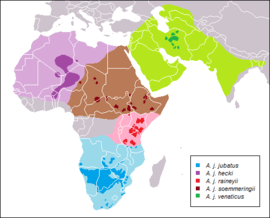Northwest African cheetah
| Northwest African cheetah[1] | |
|---|---|
 | |
| A Northwest African cheetah at Termit Massif, Niger. | |
| Scientific classification | |
| Kingdom: | Animalia |
| Phylum: | Chordata |
| Class: | Mammalia |
| Order: | Carnivora |
| Family: | Felidae |
| Genus: | Acinonyx |
| Species: | A. jubatus |
| Subspecies: | A. j. hecki |
| Trinomial name | |
| Acinonyx jubatus hecki Hilzheimer, 1913 | |
 | |
| A. j. hecki range (purple) | |
| Synonyms | |
|
Acinonyx jubatus senegalensis | |
The Northwest African cheetah (Acinonyx jubatus hecki), also known as the Saharan cheetah, is a subspecies of cheetah found in the northwestern part of Africa (particularly the central western Sahara desert and the Sahel). It is classified as critically endangered, with a total world population estimated to be about 250 mature individuals.
Physical characteristics
The Northwest African cheetah is quite different in appearance from the other African cheetahs. Its coat is shorter and nearly white in color, with spots that fade from black over the spine to light brown on the legs. The face has few or even no spots, and the tear stripes (dark stripes running from the medial canthus of each eye down the side of the muzzle to the corner of the mouth) are often missing. The body shape is basically the same as that of the sub-Saharan cheetah, except that it is somewhat smaller.[3]
Distribution and habitat
The Northwest African cheetahs ranges around the central and western Sahara desert and the Sahel in small, fragmented populations. The largest of these populations is believed to exist in the Ahaggar highlands of Algeria, but this is based on limited data obtained in 2009 from observatioikns of only four individuals.[4] Most recent records in this area are from Ahaggar National Park, some also from Tassili n'Ajjer. In Niger they occur in the northern parts of the country in the Ténéré desert and in the southern savanna region of the W National Park.[2] More than 50 cheetahs are thought to live in Algeria, compared to 10 or fewer in Niger. The total world population is estimated to be about 250 mature individuals. Besides Algeria and Niger, the range is believed to include Togo, Mali, Benin, and Burkina Faso.[5]
Former range
Northwest African cheetahs were formerly widespread throughout West Africa, ranging from Senegal to central Niger, and from Morocco to Libya and northeastern Egypt in North Africa (where its range overlapped with Sudan cheetahs).
Ecology and behavior
These animals have important physiological and behavioral adaptations that allow it to survive in the extreme conditions of the Sahara desert, where temperatures may reach up to 113 degrees Fahrenheit (45 degrees Celsius) and there is no standing water. For example, the Northwest African cheetah is even more nocturnal than other cheetahs, which helps it to conserve water and stay out of the daytime heat of the desert. In 2009, scientists from the Zoological Society of London were able to photograph a Northwest African cheetah for the first time, by the use of a nighttime camera trap in the deserts of Algeria.[4] In 2010, a Northwest African cheetah was also photographed in the deserts of the Termit Massif, Niger, using a nighttime camera trap.[6]
Social activity
These felids are usually solitary and semi-nomadic. Small groups do occur though, usually as mother and cubs or male coalitions, which usually have only a very small range. Female territories are located in areas of high prey base, which therefore determine male territories.
Hunting and diet
The main prey of the Northwest African cheetah are antelopes which have adapted to an arid environment, such as the addax, Dorcas gazelle, rhim gazelle, and dama gazelle. It may also take smaller animals such as hares. These cheetahs can subsist without direct access to water, obtaining water indirectly from the blood of their prey.[3]
See also
References
| Wikispecies has information related to: Acinonyx jubatus hecki |
| Wikimedia Commons has media related to Acinonyx jubatus hecki. |
- ↑ Wozencraft, W.C. (2005). "Order Carnivora". In Wilson, D.E.; Reeder, D.M. Mammal Species of the World: A Taxonomic and Geographic Reference (3rd ed.). Johns Hopkins University Press. p. 533. ISBN 978-0-8018-8221-0. OCLC 62265494.
- 1 2 Belbachir, F. (2008). "Acinonyx jubatus ssp. hecki". IUCN Red List of Threatened Species. Version 2008. International Union for Conservation of Nature. Retrieved 4 February 2009.
- 1 2 "All Those Spotted Cats Look Alike". Retrieved 2010-12-25.
- 1 2 Rare cheetah caught on camera trap in Sahara. The Telegraph (London). 25 February 2009. Retrieved 2009-02-25.
- ↑ Zoological Society of London. "New evidence of critically-endangered cat". Retrieved 2009-02-24.
- ↑ 'Ghostly' Saharan cheetah filmed in Niger, Africa. BBC - Earth News. Dec. 23, 2010. Retrieved 23 Dec 2010.
